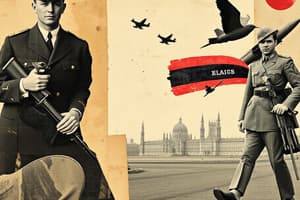Podcast
Questions and Answers
How was 1/3 of the total money raised for the war?
How was 1/3 of the total money raised for the war?
- By printing more money
- By borrowing from foreign governments
- By reducing government spending
- Through taxation such as increased income tax and excess profits tax (correct)
What type of bonds were sold to raise money for the war effort?
What type of bonds were sold to raise money for the war effort?
- Treasury Bonds and Savings Bonds
- Convertible Bonds and Junk Bonds
- Victory Bonds and Liberty Bonds (correct)
- Corporate Bonds and Municipal Bonds
What was the purpose of the Committee on Public Information?
What was the purpose of the Committee on Public Information?
- To regulate the stock market
- To promote the war effort and gain recruits (correct)
- To provide financial aid to war veterans
- To oversee international trade agreements
What negative effect did the promotion of the war effort have on society?
What negative effect did the promotion of the war effort have on society?
What happened to women during the war?
What happened to women during the war?
What was the situation of blacks in America during the war?
What was the situation of blacks in America during the war?
What caused race riots in some northern cities during the war?
What caused race riots in some northern cities during the war?
What did children do to contribute to the war effort?
What did children do to contribute to the war effort?
Who led the Committee on Public Information?
Who led the Committee on Public Information?
What was the purpose of the Loyalty Leagues?
What was the purpose of the Loyalty Leagues?
What was the purpose of the War Industries Board (WIB) during World War I?
What was the purpose of the War Industries Board (WIB) during World War I?
Which organization was responsible for boosting coal and gas production during World War I?
Which organization was responsible for boosting coal and gas production during World War I?
What was the role of the Railroad Administration during World War I?
What was the role of the Railroad Administration during World War I?
How did the War Labor Board contribute to the war effort during World War I?
How did the War Labor Board contribute to the war effort during World War I?
What was the approximate monetary cost of the World War I effort?
What was the approximate monetary cost of the World War I effort?
Who was in charge of the War Industries Board during World War I?
Who was in charge of the War Industries Board during World War I?
What methods were used to conserve energy during World War I?
What methods were used to conserve energy during World War I?
What was the primary focus of the Federal Government in raising money for the War effort during World War I?
What was the primary focus of the Federal Government in raising money for the War effort during World War I?
How did the labor leaders perceive the increase in manufacturing during World War I?
How did the labor leaders perceive the increase in manufacturing during World War I?
What was the role of the War Industries Board in relation to businesses during World War I?
What was the role of the War Industries Board in relation to businesses during World War I?
Flashcards are hidden until you start studying
Study Notes
Financing the War Effort
- One-third of the total money raised for the war was through taxation and borrowing.
- Liberty bonds were sold to raise money for the war effort.
Propaganda and Public Information
- The Committee on Public Information was established to promote the war effort and sway public opinion.
- George Creel led the Committee on Public Information.
- The purpose of the Loyalty Leagues was to promote patriotism and support for the war effort.
Social Impact
- The promotion of the war effort had a negative impact on society, leading to repression of dissent and civil liberties.
- Women's roles in society expanded during the war as they took on new jobs and responsibilities.
- The situation of blacks in America during the war was difficult, with many facing discrimination and racism.
- Race riots occurred in some northern cities due to competition for jobs and housing between black and white workers.
- Children contributed to the war effort by participating in activities such as scrap metal drives and gardening.
Economic Mobilization
- The War Industries Board (WIB) was responsible for coordinating the production of war materials and supplies.
- The Fuel Administration was responsible for boosting coal and gas production during the war.
- The Railroad Administration was responsible for managing the transportation of troops and supplies.
- The War Labor Board contributed to the war effort by mediating labor disputes and ensuring uninterrupted production.
War Costs and Leadership
- The approximate monetary cost of the World War I effort was $33 billion.
- Bernard Baruch was in charge of the War Industries Board during World War I.
- Methods used to conserve energy during World War I included daylight saving time and reduced consumption.
- The primary focus of the Federal Government in raising money for the War effort was through the sale of Liberty bonds.
- Labor leaders perceived the increase in manufacturing during World War I as an opportunity to organize and demand better wages and working conditions.
- The War Industries Board played a crucial role in coordinating businesses and industries to support the war effort.
Studying That Suits You
Use AI to generate personalized quizzes and flashcards to suit your learning preferences.




